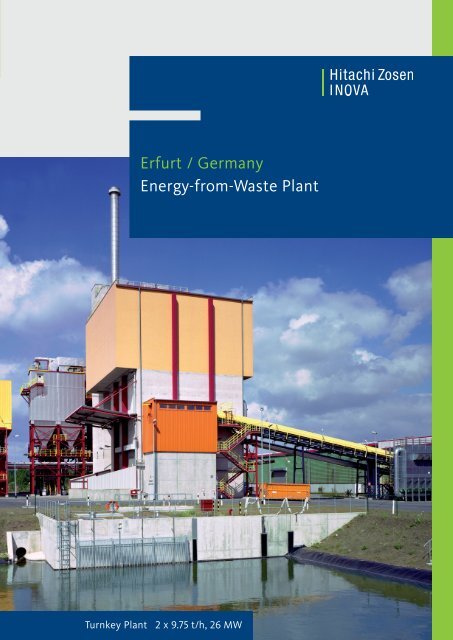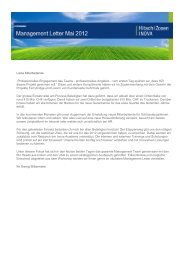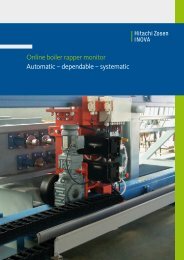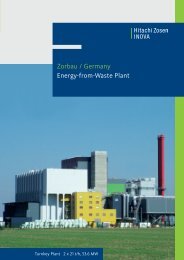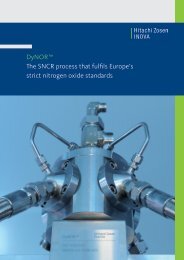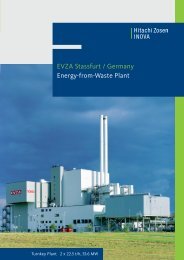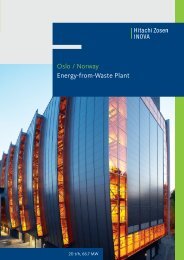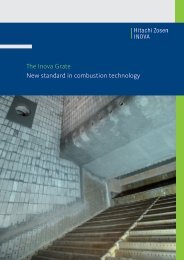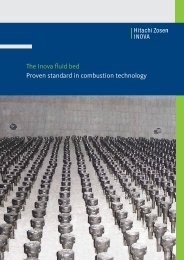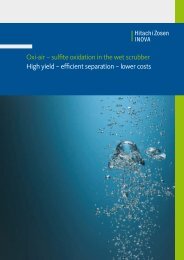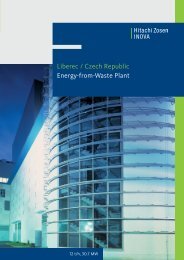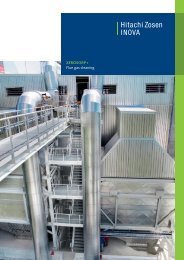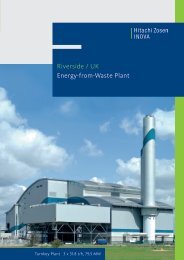Erfurt / Germany Energy-from-Waste Plant - Hitachi Zosen Inova AG
Erfurt / Germany Energy-from-Waste Plant - Hitachi Zosen Inova AG
Erfurt / Germany Energy-from-Waste Plant - Hitachi Zosen Inova AG
You also want an ePaper? Increase the reach of your titles
YUMPU automatically turns print PDFs into web optimized ePapers that Google loves.
<strong>Erfurt</strong> / <strong>Germany</strong><br />
<strong>Energy</strong>-<strong>from</strong>-<strong>Waste</strong> <strong>Plant</strong><br />
Turnkey <strong>Plant</strong> 2 x 9.75 t/h, 26 MW
<strong>Erfurt</strong> / <strong>Germany</strong> <strong>Energy</strong>-<strong>from</strong>-<strong>Waste</strong> <strong>Plant</strong><br />
<strong>Waste</strong> treatment at <strong>Erfurt</strong>:<br />
synergy <strong>from</strong> biology and energy.<br />
With the completion of the residual waste treatment plant at <strong>Erfurt</strong>, TUS Thüringer UmweltService GmbH<br />
has broken new ground in Europe. Commissioned in 2006, the plant combines mechanical-biological<br />
treatment with directly connected energy <strong>from</strong> waste conversion of the high calorific waste fractions.<br />
Integrated in the premises of an existing<br />
power plant in the eastern part of the city, the<br />
energy-<strong>from</strong>-waste plant treats the municipal solid<br />
waste <strong>from</strong> about 350,000 residents of the German<br />
federal state of Thuringia. <strong>Hitachi</strong> <strong>Zosen</strong> <strong>Inova</strong> was<br />
as general contractor responsible for the underlying<br />
design, engineering, implementation, and<br />
construction of the energy-<strong>from</strong>-waste section.<br />
Thanks to the combination of processes, the<br />
operators can respond flexible to changing waste<br />
compositions of the incoming waste by dividing<br />
the material streams into separate fractions for<br />
biological or thermal treatment. In tandem with<br />
the adjacent power plant, all energy management<br />
tasks can thus be reliably fulfilled at any time.<br />
Fuel for the energy-<strong>from</strong>-waste plant is provided by<br />
the high calorific fraction of the Mechanical-<br />
Biological Treatment plant (MBT) which is separated<br />
<strong>from</strong> the delivered waste after shredding<br />
and screening. The remaining amount of waste<br />
(about 25%) undergoes biological treatment in intensive<br />
rotting and postrotting stages before being<br />
released for disposal.<br />
<strong>Energy</strong>-<strong>from</strong>-waste with optimal process linkage<br />
The concept of the energy-<strong>from</strong>-waste plant is<br />
based on the <strong>Hitachi</strong> <strong>Zosen</strong> <strong>Inova</strong> compact plant<br />
which consists of a single process train including<br />
grate combustion system, boiler and thermal system,<br />
energy recovery, and flue gas treatment.<br />
Special fuel requires special treatment<br />
A conveyor belt carries the fuel <strong>from</strong> the MBT plant<br />
directly to interchangeable chutes <strong>from</strong> where it is<br />
dropped into a specifically for this plant designed<br />
bunker pit. The <strong>Hitachi</strong> <strong>Zosen</strong> <strong>Inova</strong> grate comprises<br />
four zones – two of them water-cooled – and<br />
ensures complete burnout of the high calorific fuels.<br />
In the overhead three-pass boiler, thermal energy<br />
is extracted and then released as cogenerated<br />
electrical power and steam to the adjacent gas and<br />
steam power plant.
13<br />
3<br />
4<br />
14<br />
16<br />
5<br />
21<br />
22<br />
12<br />
1<br />
2<br />
6<br />
7<br />
11<br />
17<br />
15<br />
19<br />
9<br />
10<br />
8<br />
18<br />
20<br />
©<br />
<strong>Waste</strong> delivery<br />
and storage<br />
Combustion<br />
and boiler<br />
Flue gas treatment<br />
1 Fuel conveyor<br />
<strong>from</strong> MBT plant<br />
2 Fuel pit<br />
3 Fuel crane<br />
4 Crane control cabin<br />
5 Feed hopper<br />
6 Ram feeder<br />
7 <strong>Hitachi</strong> <strong>Zosen</strong> <strong>Inova</strong><br />
grate<br />
8 Bottom ash discharger<br />
9 Pimary air pre-heating<br />
10 Primary air distribution<br />
11 Secondary air injection<br />
12 Rotting gas supply<br />
13 Three-pass boiler<br />
14 SNCR injection levels<br />
15 Semi-dry reactor<br />
16 Fabric filter<br />
17 Induced draft fan<br />
18 Stack consumables<br />
and residues<br />
19 Ash conveying system<br />
20 Residue conveying<br />
system<br />
21 Lime silo<br />
22 Residue silo<br />
Admixture of rotting gas saves energy<br />
and increases ecological soundness<br />
A special feature, implemented at <strong>Erfurt</strong> for the<br />
first time, is the admixture of the heavily contaminated<br />
rotting gas <strong>from</strong> the mechanical-biological<br />
treatment with additional air and its utilization as<br />
primary and secondary air. This makes it possible<br />
to comply with the legal exhaust emission limits<br />
without resorting to energy-intensive regenerative<br />
thermal oxidation (RTO). Moreover, the admixture<br />
of the rotting gas reduces exhaust emissions to the<br />
lower level of the energy-<strong>from</strong>-waste plant.<br />
Advanced flue gas treatment, safe and proven<br />
The two-stage flue gas treatment ensures that the<br />
legal emission limits are safely met at all times.<br />
While nitric oxides are destroyed in the SNCR<br />
(selective non-catalytic reduction) process, the<br />
subsequent semi-dry flue gas treatment ensures<br />
that particles, gaseous pollutants, as well as heavy<br />
metals and dioxins are safely separated.<br />
The residues consist of bottom ash for subsquent<br />
utilizazion as well as residues flue gas for offsite<br />
disposal.
<strong>Hitachi</strong> <strong>Zosen</strong> <strong>Inova</strong> <strong>AG</strong><br />
Hardturmstrasse 127<br />
P.O. Box 680<br />
8037 Zurich<br />
Switzerland<br />
Phone +41 44 277 11 11<br />
Fax +41 44 277 13 13<br />
info@hz-inova.com<br />
www.hz-inova.com<br />
<strong>Erfurt</strong> / <strong>Germany</strong> <strong>Energy</strong>-<strong>from</strong>-<strong>Waste</strong> <strong>Plant</strong><br />
General project data<br />
Owner<br />
TUS Thüringer UmweltService GmbH<br />
Year 2006<br />
Total investment<br />
EUR 43 million<br />
Scope of <strong>Hitachi</strong> <strong>Zosen</strong> <strong>Inova</strong> <strong>AG</strong> General contractor for entire plant, including civil works<br />
Technical data<br />
Annual capacity<br />
90,000 t/a entry MBT<br />
Number of trains 1<br />
Throughput per train<br />
9.75 Mg/h (nom)<br />
Calorific value of waste<br />
7 MJ/kg (min), 16 MJ/kg (max)<br />
Thermal capacity<br />
26 MW<br />
<strong>Waste</strong> type<br />
High-calorific waste fraction <strong>from</strong> MBT-plant, municipal waste<br />
<strong>Waste</strong> delivery<br />
<strong>Waste</strong> pit capacity 4,620 m 3<br />
<strong>Waste</strong> pre-treatment<br />
Bulky waste shredding, screening<br />
Combustion system<br />
Grate type<br />
<strong>Hitachi</strong> <strong>Zosen</strong> <strong>Inova</strong> grate<br />
Grate design<br />
2 rows with 4 zones per row<br />
Grate size<br />
Length 8.5 m, Width 4 m<br />
Grate cooling First two zones watercooled (Aquaroll ®)<br />
Boiler<br />
Type<br />
Three-pass boiler, horizontal<br />
Steam quantity per train<br />
29.4 t/h<br />
Steam pressure<br />
40 bar<br />
Steam temperature 400°C<br />
Flue gas outlet temperature<br />
175–220°C (end of operations campaign)<br />
Flue gas treatment<br />
Concept<br />
Flue gas volume per train<br />
Semi-dry system<br />
57,600 m 3 /h (at standard conditions)<br />
<strong>Energy</strong> recovery<br />
Type<br />
Electric power output<br />
Heat output<br />
Extraction-condensation turbine<br />
4.9 MW<br />
23.4 Mg/h 10 bar process steam<br />
Residues<br />
Bottom ash<br />
20,700 t/a<br />
Special features<br />
Admixture of the rotting gas <strong>from</strong> the mechanicalbiological treatment<br />
with additional air and its utilizationas primary and secondary air


